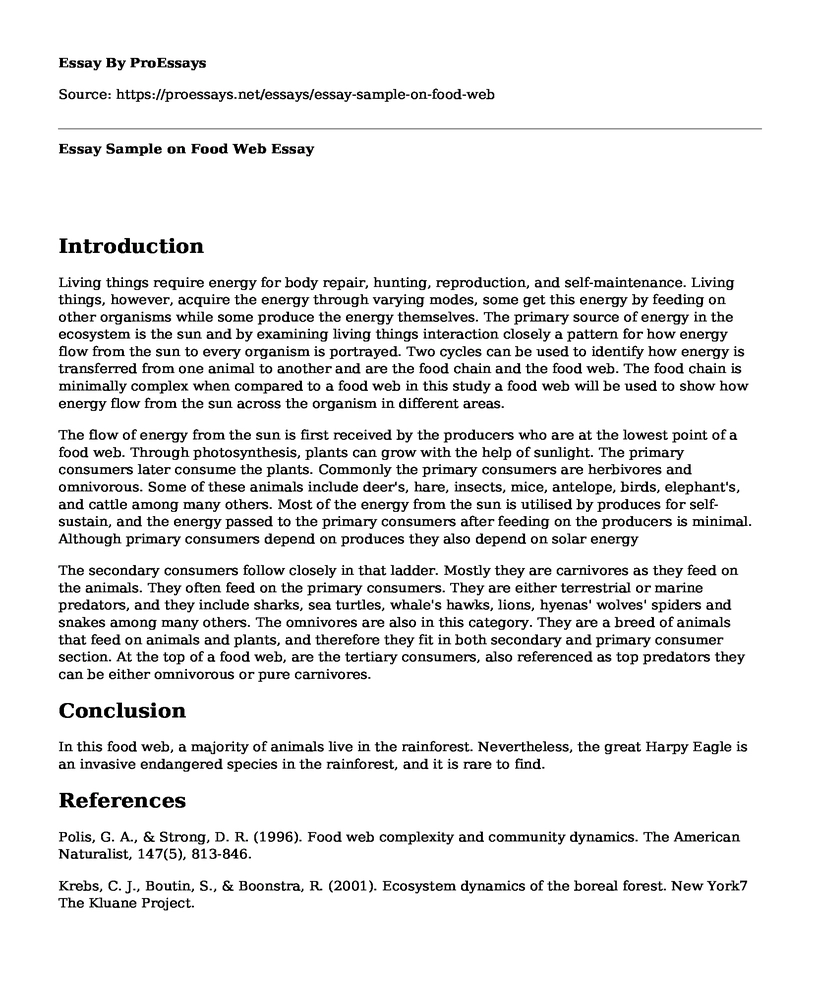Introduction
Living things require energy for body repair, hunting, reproduction, and self-maintenance. Living things, however, acquire the energy through varying modes, some get this energy by feeding on other organisms while some produce the energy themselves. The primary source of energy in the ecosystem is the sun and by examining living things interaction closely a pattern for how energy flow from the sun to every organism is portrayed. Two cycles can be used to identify how energy is transferred from one animal to another and are the food chain and the food web. The food chain is minimally complex when compared to a food web in this study a food web will be used to show how energy flow from the sun across the organism in different areas.
The flow of energy from the sun is first received by the producers who are at the lowest point of a food web. Through photosynthesis, plants can grow with the help of sunlight. The primary consumers later consume the plants. Commonly the primary consumers are herbivores and omnivorous. Some of these animals include deer's, hare, insects, mice, antelope, birds, elephant's, and cattle among many others. Most of the energy from the sun is utilised by produces for self-sustain, and the energy passed to the primary consumers after feeding on the producers is minimal. Although primary consumers depend on produces they also depend on solar energy
The secondary consumers follow closely in that ladder. Mostly they are carnivores as they feed on the animals. They often feed on the primary consumers. They are either terrestrial or marine predators, and they include sharks, sea turtles, whale's hawks, lions, hyenas' wolves' spiders and snakes among many others. The omnivores are also in this category. They are a breed of animals that feed on animals and plants, and therefore they fit in both secondary and primary consumer section. At the top of a food web, are the tertiary consumers, also referenced as top predators they can be either omnivorous or pure carnivores.
Conclusion
In this food web, a majority of animals live in the rainforest. Nevertheless, the great Harpy Eagle is an invasive endangered species in the rainforest, and it is rare to find.
References
Polis, G. A., & Strong, D. R. (1996). Food web complexity and community dynamics. The American Naturalist, 147(5), 813-846.
Krebs, C. J., Boutin, S., & Boonstra, R. (2001). Ecosystem dynamics of the boreal forest. New York7 The Kluane Project.
Cite this page
Essay Sample on Food Web. (2022, Jul 18). Retrieved from https://proessays.net/essays/essay-sample-on-food-web
If you are the original author of this essay and no longer wish to have it published on the ProEssays website, please click below to request its removal:
- Animals Rights and Wrong by Rodger Scruton Essay Example
- Compare and Contrast Humans to Animals Essay
- Saving Nature: Realizing the Impact of Human Activity - Essay Sample
- Modern Zoos: Are They Doing More Harm Than Good? - Essay Sample
- Paper Example on Exploring New Jersey's Climate and Fauna: Bears Adapt to Fluctuating Temperatures
- Index Properties of Soil - Essay Sample
- Report Example on Management of Stormwater







